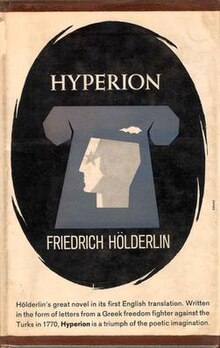Hyperion (Hölderlin novel)

First English Edition Cover
|
|
| Author | Friedrich Hölderlin |
|---|---|
| Original title | Hyperion; oder, Der Eremit in Griechenland |
| Translator | Willard R. Trask |
| Country | Germany |
| Language | German |
| Genre | Epistolary novel |
|
Publication date
|
1797 (volume 1), 1799 (volume 2) |
|
Published in English
|
1965 |
| Media type | |
| Pages | 169 |
Hyperion is an epistolary novel by German poet Friedrich Hölderlin. Originally published in two volumes in 1797 (Volume 1) and 1799 (Volume 2), respectively, the full title is Hyperion; or, The Hermit in Greece (German: "Hyperion; oder, Der Eremit in Griechenland"). Each volume is divided into two books, with each second book including an epigraph from Sophocles. The work is told in the form of letters from the protagonist, Hyperion, to his German friend Bellarmin, alongside a few letters between Hyperion and his love Diotima in the second volume of the novel, and is noted for its philosophical classicism and expressive imagery.
The novel is set in Greece and deals with invisible forces, conflicts, beauty, and hope. It recounts Hyperion's attempts to overthrow the Turkish rule in Greece (in one of the footnotes Hölderlin specifically ties events in the novel with the Russians "bringing a fleet into the Archipelago" in 1770, framing the novel's events into the Orlov Revolt), his disillusionment with the rebellion, survival in the deadly Battle of Chesma, his devastation when Diotima dies of a broken heart before they can be reunited and his subsequent life as a hermit in the Greek wilderness, where he embraces the beauty of nature and overcomes the tragedy of his solitude.
The work contains Hyperions Schicksalslied ("Hyperion's Song of Fate"), an interpolated poem on which Johannes Brahms composed the Schicksalslied, Op. 54 between 1869 and 1871.
Italian composer Luigi Nono includes passages from Hyperion in his work Fragmente-Stille, an Diotima for string quartet as part of the score to be "sung" silently by the performers while playing the piece.
In 1983, the German sculptor Angela Laich created a sculpture named Hyperion, after the main character of the Hölderlin novel.
...
Wikipedia
